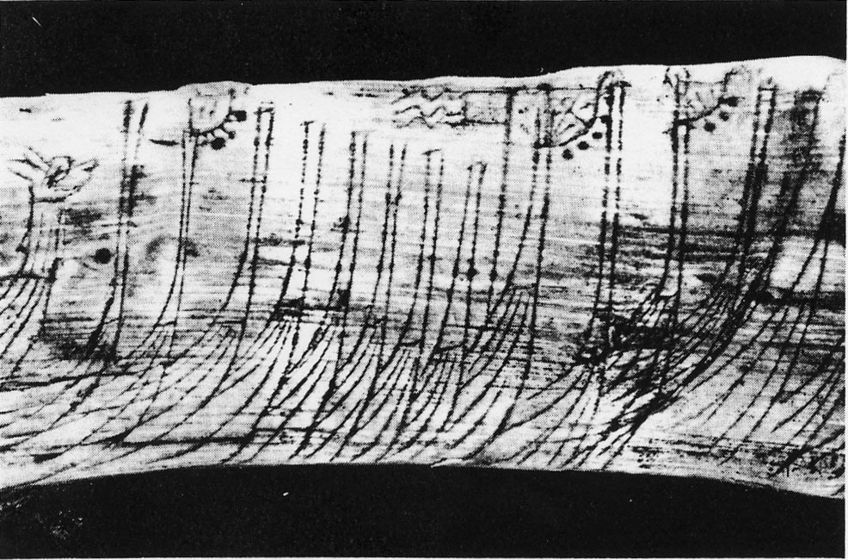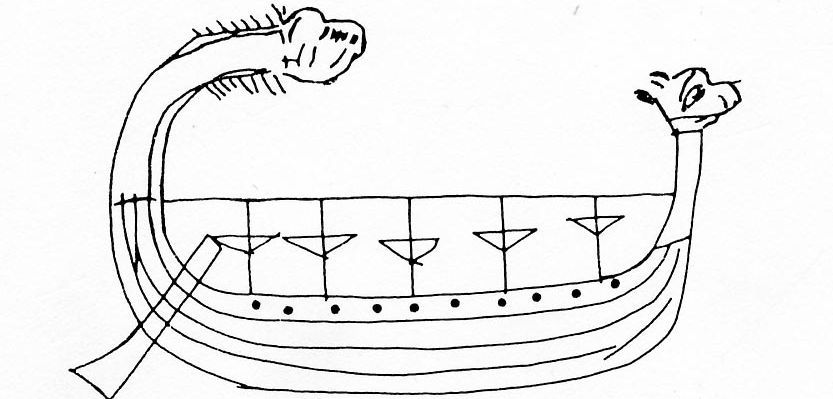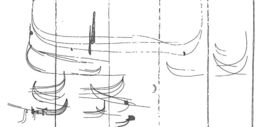Ship graffiti
Graffiti – scratched, informal drawings – are naturally found in many different contexts. This is also the case with the scratchings or carvings of ships that we know of from the period of the longships, for they turn up on church-doors, on sticks, on whetstones, on earthfast rocks and many other places. Some of them are difficult to date but as a rule it is possible to give them a terminus ante quem or a terminus post quem – a time before which, or a time after which, the graffito was made – on the basis of the dating of the object upon which the graffito was carved.
The most important graffito showing longships is found on an approx. 25 cm long stick of juniper wood, which was recovered from the excavations at Bryggen in the West Norwegain town of Bergen. The stick was found in a stratum dating from between 1248 and 1332. It had been split lengthwise and decorated with ships on both the round and the flat side. In addition it bore a runic inscription that reads Hér ferr hafdjarfr ‘Here goes the sea-brave’.
The representations of the ships on the stick are remarkable. On the flat side are seen the stems of 48 ships, in a line, overlapping each other and gradually decreasing in size towards the right so that one gets the impression of looking at a mighty fleet of ships, lying side by side. Whether this view in perspective was intended by the artist is uncertain. It is also possible that the picture is to be understood as showing that the smaller ships were of less importance (hierarchic scaling), or quite simply that they represent smaller ships, boats rather than ships. At the broken end of the stick some other ships must have been carved. On the rounded side of the stick are shown both a single, clearly large, ship in profile and a group of three stems, partly overlapping each other. On all the ship-representations the strakes are indicated by strokes but otherwise the amount of detail in the individual ships depends on their size in the depiction.
The ship-technical details that can be read out of the picture are few but significant. The stems are all the same, evenly curved type, but a distinction can be drawn between three different stem-tops. Two of the large stems, which are therefore depicted in detail, have short, sturdy stem-tops that are decorated with animal heads. The other large stems are all tall and slender but flat at the top and several of them bear so-called weather-vanes, which are decorative and often gilded plates in the form of a standard that were fastened on the tip of the stem. The largest of the ships in the picture is equipped with a weather-vane but in addition to that also with a pennant, set on a post just before the fore-stem. The smaller and clearly also less important ships are all represented with a very simple pointed stem. The animal heads and the weather-vanes, together with the tall, slender character of most of the stems, are what show that the ships in the fleet depicted really are longships.
The small group of three stems on the round side of the stick are equipped with two of the types of stem shown on the other side and they do not tell us any more about the ships. The vessel depicted in profile, however, is of a very different type. The ten oar-holes that are shown under the gunwale clearly show the vessel to be a rowing-ship. A sturdy and clearly over-dimensioned side-rudder is shown aft, while both fore-stem and aft-stem are shown with almost grotesquely large decorations. In the fore-stem this has the character of an animal head of the same type as those shown on the other side of the stick, while the motif on the aft-stem is more difficult to define today. Most remarkably, no attempt has been made to depict the ship with mast and sail. On the contrary, a horizontal line has been scratched between for- and aft-stem and at five positions, equally spaced, the line is supported by vertical lines equipped with a triangle pointing downwards. The significance of this arrangement is unknown to us today but it must have meant something to contemporary observers. It is conceivable that it represents a stand for supporting a piece of canvas – a tent canvas – that was spread out over the ship – but it can alternatively have been a part of the ship’s battle equipment, e.g. the support for a flying bridge or a series of raised platforms for shooting from – High Medieval warships were to a much higher degree than Viking-Age ships a kind of “flying fortress”, where it was not unusual to raise towers and other constructions on board in order to ensure advantages against the enemy in the remorseless struggle man to man that still characterised naval warfare.<//font><//font>
Many of the Norwegian stave churches have parts of their timber construction that can be dated right back to the twelfth and thirteenth centuries. On many of these are found graffiti in the form of carved ship-representations but it is most often only the stems and not whole ships that are depicted. One exception is the stave church from Fortun, where the long, slender profile of a warship dominates the carvings on the inside of the north wall of the nave. The reason why there are so many ship-graffiti on the stave churches is unknown but it is assumed that most of them were the work of the craftsmen who built the churches. It is possible to imagine a religious significance for the carvings – the part of the church building where the congregation sits is called kirkeskibet ‘the nave’ from Latin navis ‘ship’ because the ship has from antiquity been employed as a metaphor for the Christian church. It is also conceivable, however, that the same craftsmen who built and decorated the churches, were also those who built and decorated the great ships. As can be seen from the text in Snorri Sturluson’s saga about Olav Tryggvason’s ORMR INN LANGI, it was precisely the shaping of the stems that was one of the most prestigious tasks involved in shipbuilding and this would certainly have been the object of much discussion between the shipbuilders.
Danish text: Jan Bill
Translation: Gillian Fellows-Jensen
Read more:
The "Bryggen Shipstick": A Challenge in Art and Ship Technology by Liz le Bon in Ships and Commodities edited by Ingvild Øye, Ann Christensson & Else Mundahl, The Bryggen Papers, Supplementary Series 7, pp. 9-34, Bergen University Press, Bergen 2001
Ship Graffiti by Arne Emil Christensen in The Ship as Symbol in Prehistoric and Medieval Scandinavia edited by Ole Crumlin-Pedersen & Birgitte Munch Thye, Publications from the National Museum 1, pp. 180-185, The National Museum, Copenhagen 1995
Graffiti in Norwegian stave churches, c. 1150 - c. 1350 by Martin Blindheim. University Press, Oslo 1985


